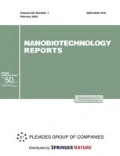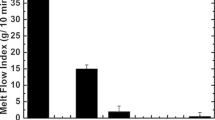Abstract
In this paper, we study the physicomechanical and electrophysical properties of filaments of a nanocomposite made of a copolymer of acrylonitrile with butadiene and styrene (ABS)/multi-walled carbon nanotubes (MCNTs) for FDM-printing (Fusing Deposition Modeling). Both native (TMN) and functionalized (TMF) multiwalled carbon nanotubes were used as fillers. The strength of the filament is shown to depend nonlinearly on the MCNT concentration. The strength initially decreases by 24–34%, and then, as the concentration increases, at 5 wt % of filler increases to values that are 3–5% less than that of unmodified ABS. The filament resistivity reaches 1.1 × 103 and 7.2 × 104 Ω m for TMN and TMF, respectively (the filler concentration is 5 wt %). The power-law dependence of the resistivity on the nanofiller concentration was found to be violated, which is possibly related to segregation of phases with different conductivity in the nanocomposite. The maximum value of the resistivity occurs at a concentration of 2.5 wt % ТМН when the phase with higher conductivity does not yet form a single network, but represents “islands” separated from each other by areas with lower conductivity. Violations of the power-law dependence disappear in the case of saturation of the filament with TMN with water or using TMF as a nanofiller. Changes in the morphology and microstructure of the filament surface were studied by electron microscopy. An increase in the MCNT concentration is shown to lead to a “smoothing” of the surface and may be associated with a deeper relaxation of the shrinkage stresses compressing the filament. The effect manifests itself at minimal TMN concentrations. When using TMP, “smoothing” of the surface is observed at a maximum concentration of 5 wt %. It is shown that the physicomechanical and electrically conductive properties of filaments are determined by the processes of separation of the phases with different conductivity and shrinkage that occur simultaneously during filament production.




Similar content being viewed by others
REFERENCES
E. N. Kablov, Met. Evraz., No. 3, 2 (2017).
E. N. Kablov, Intell. Tekhnol., No. 2 (14), 16 (2016).
E. N. Kablov, Aviats. Mater. Tekhnol., No. 1 (34), 3 (2015). https://doi.org/10.18577/2071-9140-2015-0-1-3-33
E. N. Kablov, Collection of Scientific Information Materials, 3rd ed. (VIAM, Moscow, 2015) [in Russian].
A. E. Sorokin, M. M. Platonov, and S. A. Larionov, Tr. VIAM, Elektron. Nauch.-Tekh. Zh., No. 9, 35 (2017). https://doi.org/10.18577/2307-6046-2017-0-9-5-5
B. S. Kirin, S. L. Lonskii, G. N. Petrova, and A. E. Sorokin, Tr. VIAM, Elektron. Nauch.-Tekh. Zh., No. 4 (76), 7 (2019). https://doi.org/10.18577/2307-6046-2019-0-4-21-29
S. V. Kondrashov, A. A. Pykhtin, S. A. Larionov, and A. E. Sorokin, Tr. VIAM, Elektron. Nauch.-Tekh. Zh., No. 10 (82), 04 (2019). https://doi.org/10.18577/2307-6046-2019-0-10-34-49
L. M. Bollig, P. J. Hilpisch, G. S. Mowry, and B. B. Nelson-Cheeseman, J. Magn. Magn. Mater. 442, 97 (2017). https://doi.org/10.1016/j.jmmm.2017.06.070
B. Khatri, K. Lappe, D. Noetzel, et al., Materials 11, 189 (2018). https://doi.org/10.3390/ma11020189
S. J. Leigh, C. P. Purssell, D. R. Billson, and D. Hutchins, Smart Mater. Struct. 23, 095039 (2014).
E. M. Palmero, J. Rial, J. de Vicente, et al., Sci. Technol. Adv. Mater. 19, 465 (2018). https://doi.org/10.1080/14686996.2018.1471321
C. Huber, C. Abert, F. Bruckner, et al., Sci. Rep. 8, 1 (2017). https://doi.org/10.1038/s41598-017-09864-0
Y. Jia, H. He, Y. Geng, et al., Compos. Sci. Technol. 145, 55 (2017). https://doi.org/10.1016/j.compscitech.2017.03.035
S. Waheed, J. M. Cabot, P. Smejkal, et al., ACS Appl. Mater. Interfaces 11, 4353 (2019). https://doi.org/10.1021/acsami.8b18232
T. J. Quill, M. K. Smith, T. Zhou, et al., Appl. Compos. Mater. 25, 1205 (2018). https://doi.org/10.1007/s10443-017-9661-1
M. A. Cruz, S. Ye, M. J. Kim, et al., Part. Part. Syst. Char. 35, 1700385 (2018). https://doi.org/10.1002/ppsc.201700385
Z. Lei, Z. Chen, H. Peng, et al., J. Mater. Sci. 53, 14495 (2018). https://doi.org/10.1007/s10853-018-2645-1
H. K. Sezer and O. Eren, J. Manuf. Process. 37, 339 (2019). https://doi.org/10.1016/j.jmapro.2018.12.004
L. Yang, S. Li, X. Zhou, et al., Synth. Met. 253, 122 (2019). https://doi.org/10.1016/j.synthmet.2019.05.008
W. W. Yu, J. Zhang, J. R. Wu, et al., J. Appl. Polym. Sci. 134, 44703 (2017). https://doi.org/10.1002/app.44703
G. Spinelli, P. Lamberti, V. Tucci, et al., Composites, Part B 167, 467 (2019). https://doi.org/10.1016/j.compositesb.2019.03.021
K. Gnanasekaran, T. Heijmans, S. van Bennekom, et al., Appl. Mater. Today 9, 21 (2017). https://doi.org/10.1016/j.apmt.2017.04.003
W. Ye, W. Wu, X. Hu, et al., Compos. Sci. Technol. 182, 107671 (2019). https://doi.org/10.1016/j.compscitech.2019.05.028
S. Agarwala, G. L. Goh, G. D. Goh, et al., in 3D and 4D Printing of Polymer Nanocomposite Materials (Elsevier, Amsterdam, 2020), p. 297. https://doi.org/10.1016/B978-0-12-816805-9.00010-7
A. Joshi, J. K. Goh, and K. E. J. Goh, in 3D and 4D Printing of Polymer Nanocomposite Materials (Elsevier, Amsterdam, 2020), p. 45. https://doi.org/10.1016/B978-0-12-816805-9.00003-X
M. R. Khosravani and T. Reinicke, Sens. Actuators, A, 111916 (2020). https://doi.org/10.1016/j.sna.2020.111916
I. Alig, P. Pötschke, D. Lellinger, et al., Polymer 53, 4 (2012). https://doi.org/10.1016/j.polymer.2011.10.063
T. Villmow, S. Pegel, P. Pötschke, and U. Wagenknecht, Compos. Sci. Technol. 68, 777 (2008). https://doi.org/10.1016/j.compscitech.2007.08.031
F. H. Gojny, M. H. G. Wichmann, B. Fiedler, et al., Polymer 47, 2036 (2006). https://doi.org/10.1016/j.polymer.2006.01.029
I. Alig, D. Lellinger, and T. Skipa, Polymer–Carbon Nanotube Composites Preparation, Properties, and Applications (Woodhead, Cambridge, 2011), p. 295. https://doi.org/10.1533/9780857091390.2.295
J. Tiusanen, D. Vlasveeld, and J. Vuorinen, Compos. Sci. Technol. 72, 1741 (2012). https://doi.org/10.1016/j.compscitech.2012.07.009
The Chemist’s Handbook 21. https://www.chem21.info/info/981228/.
P. Bonnet, D. Sireude, B. Garnier, and O. Chauvet, Appl. Phys. Lett. 91, 201910 (2007). https://doi.org/10.1063/1.2813625
I. D. Simonov-Emel’yanov, A. A. Pykhtin, S. A. Smotrova, and A. N. Kovaleva, Polym. Sci. D 10, 236 (2017). https://doi.org/10.1134/S1995421217030169
I. D. Simonov-Emel’yanov, A. A. Pykhtin, and K. A. Mikhal’chenko, Nanotechnol. Russ. 13, 372 (2018). https://doi.org/10.1134/S1995078018040146
I. A. Mansurova et al., Izv. Vyssh. Uchebn. Zaved., Khim. Khim. Tekhnol. 62 (11), 106 (2019).
Funding
This work was supported by the Russian Foundation for Basic Research, grant no. 18-03-00371a.
Author information
Authors and Affiliations
Corresponding author
Additional information
Translated by A. Ivanov
Rights and permissions
About this article
Cite this article
Sorokin, A.E., Pykhtin, A.A., Larionov, S.A. et al. Formation Features of Electric Conductive Networks in the ABS/MCNT Composite when Manufacturing Filament for FDM-Printing. Nanotechnol Russia 16, 473–479 (2021). https://doi.org/10.1134/S2635167621040133
Received:
Revised:
Accepted:
Published:
Issue Date:
DOI: https://doi.org/10.1134/S2635167621040133



